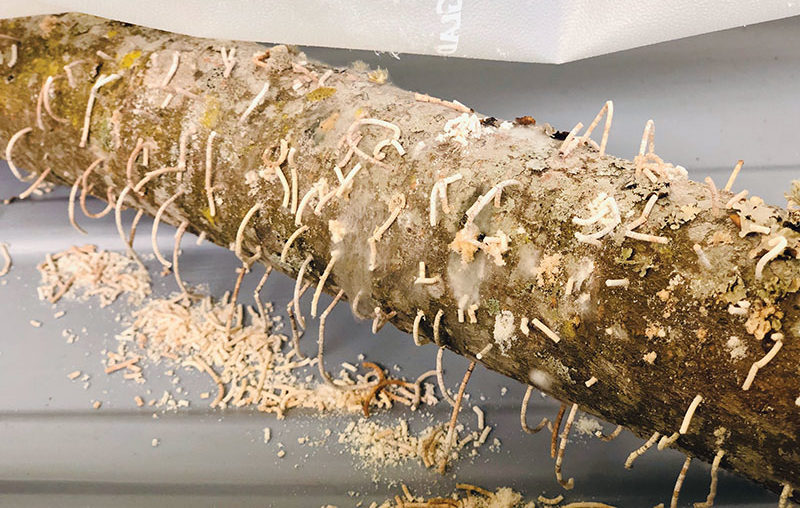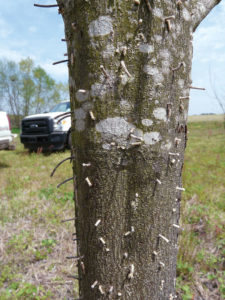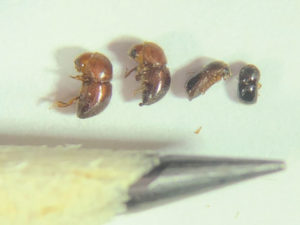
May/June 2022
Toothpicks in the trees
Accidentally imported in the 1970s, the Asian ambrosia beetle has been a problem for growers up and down the Atlantic Seaboard, but especially in the Southeast. It gets its name from the fungi that it not only feeds from, but the same one it spreads by burrowing into the tree. The beetle and the ambrosia fungus have a symbiotic relationship – the fungi relying on the beetle for transportation in exchange for a food source. The beetle larvae feed on the fungi, and when they grow to maturity, the adult beetle stores spores in its body, leaving for another tree to introduce the fungus further. The fungi does not harm the tree.
While ambrosia beetle prefers to attack certain ornamental trees, such as the Japanese maple, it’s attracted to other hardwood trees as well.
Pecan happens to be one of those hardwoods.
Young tree target
In 2012-2014, Georgia saw a dramatic increase in newly planted pecan orchards, which was then followed by an uptick in ambrosia beetle infestation. One- to three-year-old trees are the most susceptible. While three-year-old trees are less susceptible, it simply requires more beetles to damage a tree that is a little older and larger caliper.
Females bore into trees, but do not feed on the tree, leaving toothpick-like protrusions of sawdust around the boreholes, making infestations easy to spot. These protrusions remain in place unless they’re washed or blown away by rain or wind. There may also be white boring dust around the base of the tree as well, depending on how recently the beetle has burrowed.

Typically, an infested orchard can lose approximately 5-10% of newly planted trees, depending on how active the ambrosia beetle is in the area at that time of year. While 10% is high, there are a number of reasons that could contribute to this – frost, lack of irrigation, nutrient deficiency. Ultimately, and like most pest problems, stressed trees are more likely to become affected, and younger trees are more easily stressed.
This may not seem like too much of a problem for large growers, who often take the loss and simply replant the tree. Smaller growers, however, particularly those with fields against wooded, forested areas, may be more concerned. More tree line means more access for the pest.
An ingenious trap
First flight is in late February and early March, with an additional flight in late April and into May, with the summer months seeing a break.
“Once you get into June, that species is very inactive for the rest of the year,” said Andrew Sawyer, area pecan agent for University of Georgia (UGA) Extension.
But it can be difficult to measure pest pressure.
Researchers devised a way to determine the activity level of the beetle by making a simple yet effective trap – a hardwood log without developed bark, semi-hollowed out and filled with denatured alcohol and corked.
“Like all insects, ambrosia beetle responds to a chemical signal, a pheromone, and the pheromone in this case is ethylene,” said Sawyer. “A lot happens inside the tree when it’s stressed, and when this happens, ethylene is released.”
The log mimics a stressed tree. Growers can get an idea of ambrosia beetle pressure based on the number of sawdust strands present when checked. The traps would need to be checked before a rain, or reset after a rain, as the sawdust would no longer be present. Trapping and monitoring should begin in February and March and the trap checked, and likely refilled, weekly.
It’s almost impossible to tell the exact population of the beetle, and Sawyer recommends placing a trap approximately every 100 yards, thinking in terms of linear footage between the pecan trees and the forest trees. Georgia, home to 24 million acres of forestry, provides an ample breeding ground for such insects, and many pecan orchards are farmed right up against the forest lines.
“The traps would be set along the sides of the woods. If there’s a pasture on the other side, traps wouldn’t need to be set on that side,” said Sawyer.
The beetles themselves are not fantastic flyers, and will generally only target the outermost trees near the wood line. Though not impossible, it’s unlikely to find ambrosia beetle in the center of an orchard.

Control methods
UGA researchers have tested a few methods for ambrosia beetle control. One is a simple insecticide spray. Another is to paint the bark of a tree with white latex paint, then spraying the tree with a pyrethroid before the paint dries.
For most growers, it’s easier to spray, but with the spray option comes multiple applications throughout the season. Recent studies have proven that both ways are effective, but the paint has a specific advantage: It won’t wash off in the rain and has a residual effect, meaning it only has to be done once for the season. Even under normal conditions, the pyrethroid spray treatment would have to be applied every 10-14 days.
Tree guards, which are commonly used as herbicide protection for young trees, may pose another problem – ambrosia beetles like to hide inside them.
“This means you have to spray down in them, and the airblast sprayers don’t get into the tree guards,” said Sawyer.
Growers would either have to take off all the guards, or load a 20-gallon sprayer onto their four-wheeler and use a hand wand to spray into each one.
UGA Extension does currently recommend spraying at a rate of 1-2 ounces of pyrethroid per 10 gallons of water when it’s found that beetles are active. Once the beetle has bored into the tree, no topical use of pyrethroids will work, but if the tree is sprayed just after it was hit, growers can potentially save a tree if only a few beetles have attacked it.
Though tree death does happen, not all trees affected by the beetle will die. The beetle could kill a bigger, older tree, but it’s unusual, and it would take a large number of beetles to do so. It would also take a number of years.
“Some growers, even with hundreds of acres, are trying to spray every tree. Other large growers are playing their odds,” said Sawyer, and those will spot spray if necessary. “But smaller growers, they’re the ones trying to do a lot of this control. They don’t have as many trees, and the more they can keep them alive, the better.
A log trap shows high ambrosia beetle pressure. Photo: University of Georgia







